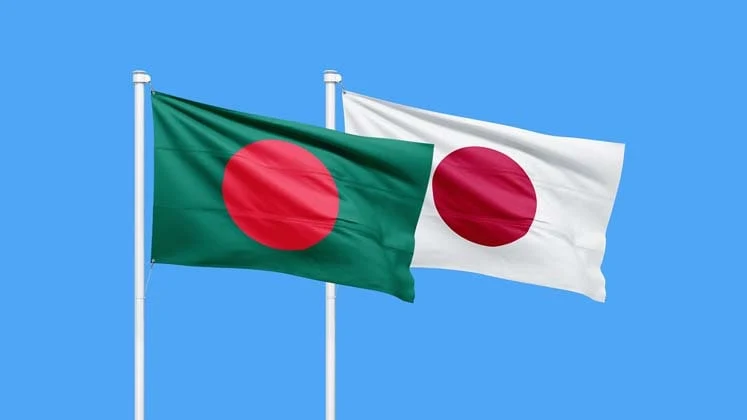Flags hold significant meaning as they represent the identity, culture, and aspirations of a nation. Often, flags are designed with deep symbolism and historical references. In the case of Bangladesh and Japan, two countries geographically distant but connected through shared experiences, an intriguing similarity can be observed between their national flags. This article aims to explore the reasons behind the resemblance of the Bangladeshi and Japanese national flags, delving into their historical backgrounds, symbolism, and cultural contexts. By understanding this resemblance, we can gain insight into the enduring power of flags as symbols of unity and inspiration.
 |
| Flags of Bangladesh and Japan |
Table of contents
- 1. Introduction
- 2. The Bangladeshi National Flag: A Symbol of Liberation
- 3. The Japanese National Flag: A Symbol of Tradition and Resilience
- 4. The Resemblance: Uniting Threads of History and Philosophy
- Shared Values and Aspirations: Reflections on Resemblance
- 6. Conclusion: Flags as Bridges of Understanding
1. Introduction
Flags have served as symbols of national identity and unity for centuries. They embody the values, struggles, and aspirations of a nation, representing a tangible visual representation of its people. The flags of Bangladesh and Japan hold profound significance, reflecting the essence of their respective cultures and histories.
2. The Bangladeshi National Flag: A Symbol of Liberation
2.1 Historical Background of Bangladesh’s Liberation Struggle
The Bangladeshi flag holds a pivotal place in the nation’s history. Bangladesh, formerly known as East Pakistan, fought for its independence from Pakistan in a liberation war in 1971. The war resulted in the birth of Bangladesh as a sovereign nation.
2.2 Design and Symbolism of the Bangladeshi Flag
The Bangladeshi flag consists of a green field with a red circle in the middle. The green color represents the lushness and fertility of the land, while the red circle symbolizes the bloodshed and sacrifices made during the liberation struggle. The designer of the national flag of Bangladesh is Quamrul Hasan.
 |
| The National Flag of People's Republic of Bangladesh |
2.3 Significance of the Green and Red Colors
The green color also symbolizes the vibrant spirit of the Bangladeshi people, their love for nature, and their hope for a prosperous future. The red circle represents the courage and resilience of those who fought for the nation’s independence.
3. The Japanese National Flag: A Symbol of Tradition and Resilience
3.1 Historical Background of the Japanese Flag
The Japanese flag, known as the Nisshōki or Hinomaru, has a rich historical background dating back to ancient times. It has been used in various forms throughout Japan’s long history.
3.2 Design and Symbolism of the Japanese Flag
The Japanese flag consists of a white field with a red circle in the center, resembling the rising sun. The simplicity and elegance of the design have remained unchanged for centuries.
 |
| National Flag of Japan |
3.3 The Rising Sun and Its Cultural Significance
The rising sun has deep cultural significance in Japan, representing the country’s unique blend of tradition and modernity. It symbolizes hope, enlightenment, and a new beginning. The red circle on the flag is associated with the sun and serves as a representation of the Japanese people’s resilience and strength.
4. The Resemblance: Uniting Threads of History and Philosophy
4.1 The Similarity in Colors and Shapes
At first glance, the resemblance between the Bangladeshi and Japanese flags is striking. Both flags feature a simple design with a red circle placed on a field of a specific color, green in the case of Bangladesh and white in the case of Japan.
4.2 Shared Historical Experiences
The resemblance between the flags can be attributed, in part, to shared historical experiences. Both Bangladesh and Japan have experienced struggles and conflicts that have shaped their respective nations. In the case of Bangladesh, the liberation war led to the creation of a new nation, while Japan has endured periods of intense transformation and resilience throughout its history.
4.3 The Influence of Japanese Philosophy on Bangladesh
Furthermore, Japanese philosophy and culture have had a profound impact on Bangladesh. The principles of discipline, hard work, and innovation have inspired the people of Bangladesh, leading to economic growth and development. This influence can be seen as a bridge that connects the two nations, further strengthening the resemblance between their flags.
It is believed that It is no coincidence that the Bangladeshi national flag resembles the Japanese flag. The father of the nation and president of Bangladesh at that time, Bangabandhu Sheikh Mujibur Rahman, was impressed by the development of Japan from an agricultural country to an industrial one. He wanted Bangladesh to be like Japan and so he adopted the design of the Japanese flag. [Team MRM is not able to provide proper documents for this statement.]
Shared Values and Aspirations: Reflections on Resemblance
5.1 Strength in Unity: Inspiring Nationalism
The similarity between the Bangladeshi and Japanese flags serves as a reminder of the power of unity and nationalism. Both flags embody the spirit of their people and their shared determination to overcome challenges and build a better future.
5.2 The Power of Resilience and Progress
The resemblance also highlights the resilience and progress of both nations. Bangladesh and Japan have faced adversity but have managed to emerge stronger. The flags stand as symbols of their nations’ ability to overcome obstacles and strive for progress.
5.3 Mutual Respect and Cultural Exchange
The similarity between the flags fosters mutual respect and cultural exchange between Bangladesh and Japan. It serves as a symbol of the strong and growing relationship between the two nations, encouraging collaboration in various fields such as trade, technology, and cultural exchange.
6. Conclusion: Flags as Bridges of Understanding
The resemblance between the Bangladeshi and Japanese national flags is a testament to the power of symbols and their ability to bridge cultures and foster understanding. While geographically distant, Bangladesh and Japan share common threads in their history, values, and aspirations. By recognizing and appreciating these similarities, we can further strengthen the bonds between nations and promote a world where diversity and unity coexist.

Post a Comment
Write you think.